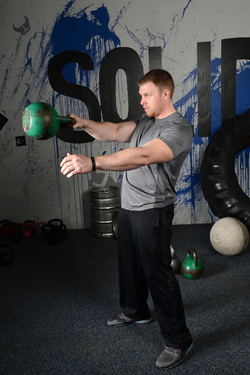
I know there are people out there that don't understand the power of a kettlebell swing and I'm sure every gym BRO is screaming out, "you're gonna lose your gainz doing all that cardio." The reason for a challenge like this is the overwhelming benefits of the swing. I think at this point in my kettlebell career I could write a small novel on the benefits of the swing, but this is a blog, so I'm going to lay out the benefits by three each blog entry. Here are the first three based on the audience I have reading.
Improve your dead lift and squat- The swing is a movement generated through the powerful extension of the hips. This movement involves mostly the hamstrings, gluteus maximus and minimus, and your entire back erector group. These muscles are highly active in a dead lift and squat. I have noticed a direct improvement at the lockout point of a dead lift and squat when someone has incorporated the swing into their plan. The swing will build the hips to lock out more weight and teach the body to lock in the glutes to protect the back and hips. Some people in the strength community even believe the swing to be superior to the dead lift due to the fact that it maintains tension on the glutes and hamstrings throughout the entire motion; where as, the dead lift can translate the tension to the lower back at the lockout.
Jump higher- as explained earlier the swing will work the glutes in an explosive fashion. The glutes play a key role in jumping off the ground. The strength of your glutes has a direct correlation to the height and distance of your jumping. Doing the regular swing will have a positive impact on your jumps, but some sports like basketball involve springing off of one leg as well as two. This is when you can mix in some "one-leg" swings by putting one foot on a BOSU ball or balance disc and focusing more on the power generated from the leg planted on the ground. This will help to work the glutes and hamstrings unilaterally and improve your one leg jumps.
Build true core strength- almost everything mentioned about the swing talks about how it builds the glutes, hamstrings, and back, but did you know the swing is a great abdominal training exercise, also? I talked briefly about tension in my last swing article and that maintaining core tension is optimal for a proper swing. You should be focused not only on squeezing the abs at the top of your swing, but also work on building your inter-abdominal pressure. The best way to describe this is the pressure you build when you are trying having a bowel movement. This pressure will activate deep core muscles and will build the pelvic wall. This is key for anyone trying to have a big dead lift and squat(along with helping you POOP better). This technique takes some practice, but you will notice an immediate strength gain in all of your lifts when you master it. By building your inter-abdominal pressure you lower your chances of injuring your back when performing major lifts.
I could go on all day on why everyone should incorporate swings into their plan, but I think this is a good start. There are many ways to perform swings based on your personal goals. Someone focusing on max strength should perform <15 swings per set and work with heavier weights and double kettlebells. Someone who wants to build their muscle tone or endurance, like runners, can work in higher rep ranges like 20-50 per set or even timed sets. Experiment with different ranges of repetitions and see which one you like best. I usually suggest everyone start with high rep ranges to practice technique and build their muscular endurance.
The swing has drastically changed my training and I know it will help you, too.

 RSS Feed
RSS Feed
